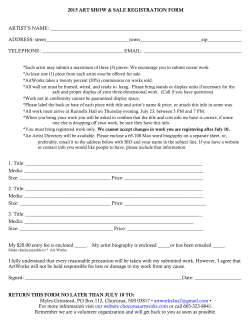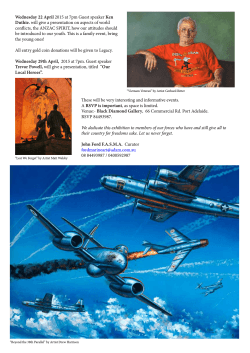
THE BANGLE SERIES
T HE BA NG L E SE R I E S Medium : Mixed Media Period : 2013 onwards KISAL AY VOR A FINE ARTIST MUMBAI, INDIA. Dear Gallerist, Kisalay Vora is an artist who has been using the medium of art to express social relevant messages from his very youth and has long been involved in creating art with a message. His recent works are no exception. Using bangles as a central theme, Kisalay wants to renegotiate the social symbolism associated with them. Even today, in a day and age when gender equality is much touted about and feminism has fought many a battle to survive, bangles are being used as objects of shame and derision accompanied by the slur, “Choodiyan pehen rakhi hain kya?” Wanting to imbue this symbol of bangles with a reversal of meaning, Kisalay has invested his time, energy and effort to start a movement that will not only draw attention to this issue but also encourage people to think about how they demean women by using such phrases unthinkingly. In his mission to take this message far and wide, he is fulfilling his dream of being an artist who gives back to society, who touches people with his art and empowers them to make a change in the very fabric of socio-cultural norms. Kisalay invites you to be an ally in this movement, helping to carry the message to art connoisseurs, art lovers and everyone who comes in contact with you. Please find attached a short note on the theme of using bangles in his artworks. THE BANGLE SERIES 1. Two Sisters 2. Pride 3. Distortions in the image are deliberate... 4. What’s in a name... 5. Beautiful Bangle Stand Artist Kisalay P Vora is passionate about bangles. While for most women bangles are just another adornment in daily life, they have long been used as a symbol of shame and weakness in India. The Hindi phrase, “Choodiyan pehen rakhi hain kya?” when directed at a person, implies that the person is weak and a coward. This phrase drove Kisalay to distraction and made him want to change the very connotation of the sentence. “Why bangles? What’s weak about bangles? It’s like saying: You are like women, therefore you are weak. Why are women saying this? What cultural message are they sending out when they do this?” asks Kisalay. In a bid to change the very notion that bangles are symbols of weakness, Kisalay has created a series to draw attention to this issue, championing the cause of equality and drawing attention to the subliminal messages embedded with these oft repeated and demeaning phrases. Kisalay has chosen bangles as the vehicle for his message because of their inherent beauty and symbolism. Elevating them from their role as mere adornments and accessories, he has placed them in a context that makes them meaningful and which raises them to a different perspective. “I have heard many women saying “ladki ki tarah mat roh”, or “yeh meri beti nahin, mera beta hai” or the ultimate: gifting boxes of bangles to men in power, as a way of telling them: you are weak. For me, that’s a very disturbing image,” Kisalay remarks. His works on this theme represent the dichotomy of power and weakness, pride and shame, courage and cowardice - from employing a spine to represent the strength of a person while simultaneously using it as a stand to display bangles, to the sculpture of a macho, muscular arm adorned with large glitzy bangles, Kisalay wants his pieces to evoke a visceral reaction from the viewer and enable them to realize that femininity is a source of positive energy and not the reverse, and it needs to be respected as such. “Equality cannot be given, it must be taken. Until women correct their attitude toward themselves, any equality that is introduced from the outside, will be thrown away. Society will bend forward and women will bend further back. The gap will remain,” says Kisalay. The solution? “The solution is to register your protest, as I have in my works, and hope it catches on and becomes a movement. Bangles are objects of beauty, not of weakness! So the next time you gift bangles to someone, gift them to honor the person,” concludes Kisalay. For more information, please contact the artist Kisalay P Vora on +91 98206 90660 or email him on kisalaypvora@rediffmail.com. Please visit his facebook page: https://www.facebook.com/kisalayvoraartist “Choodiyan pehen rakhi hai kya?’ means ‘Have you worn bangles?’. This phrase is used very casually in India when one wants to belittle a man. Its a strong gender biased comment, and even women have accepted it as a coping mechanism . “Ladki ki tarah mat roh” meaning ‘Don’t cry like a girl’ or “Yeh meri beti nahin, mera beta hai” meaning ‘This is not my daughter, she is my son!’... are used regularly in practically every home. These statements have been used over the centuries without being questioned for the gender bias they propagate. Portrait of Two Sisters The Gold and Green bangles are a symbols for marriage in different parts of India. The Red powder (kum kum) is a symbol for marriage worn by women in many parts of the country, mostly among Hindus. The Wheat signifies the nuturing aspect of women. All of these strongly connect to beauty, adornment and the dreams of Indian women. Medium : Mixed Media... Metal bangles, Wood, Kum Kum (red powder), Wheat grains painted gold. Size: 14 inches x 18 inches (without frame) New frames are begin manufactured to fit around the two pieces which will make the eventual size... 20.5 inches x 24.5 inches. Pride It takes a very strong man to see pride in bangles (against the popular indian phrase “Choodiyan pehen rakhi hain kya?”) Medium : Fibre glass, Wood, Bangles fabricated from plastic (which is then painted gold) and set with coloured synthetic stones. Size : Arm - 2 ft 1 inch, Pedestal - 2 ft 10 inches Distortion in the image is deliberate... Mirror behind the bangles is wobbly to create distortions. It serves as a reflection of society. Medium : Acrylic mirrors, Metal bangles, and Fibre glass Spine on Wooden board. Size : 5 ft x 4ft 2 inches What’s in a name... The Red and Cream bangles are a symbol for marriage in North Indian Hindus and Sikhs. Burkha identifies a Muslim woman. There is a woman beyond these barriers and symbolism...always unknown. Medium : Acrylic on Canvas Size : 4 ft x 5 ft approx Beautiful bangle stand The strength of the spine holds the beauty of the bangles. Medium : Metal Bangles, Fibre glass, Rubber, Wood and Mirror pasted on wooden stand base (can be seen when the piece is placed below eye level) Size : Length 2 ft 9 inches Work in progress... Gift Articles Gift boxes with spinal cord sections. Ribbons yet to be added. Work in progress... What are you waiting for? Extension to the expression of Womens’ equality. In this piece i have used windows as a symbol of path to freedom and equlity. The windows, some closed some partly open, full of decorative materials and intricate design call for female energy to open the colourful windows to the future. Medium : Wood, Sequins, Glass, Feathers, Cloth and a backlight. I may add bangles to it later if i feel the need to. Size : 3ft 3 inches x 3 ft Work in progress... When backlit... Work in progress... When backlit... Work in progress... Corner Detail Work in progress... Untold Stories and Dreams Concept is built around hopes desires and unexpressed stories of a Womans’s life. Mixed Media : Wood, Sacred Thread, Bangles, Etc... In my studio... A Brief Bio-data A journey through the life of artist Kisalay P Vora is an interesting and complex one traversing the fields of different visual media to culminate in a career marked by achievements in diverse fields. Citing art, literature and music as his primary influences, Kisalay’s artistic self sought expression from the age of five, when he began drawing with charcoals on walls opposite his family home at Mandvi, a small town in Kutch, Gujarat. Parental influence added life into his shapes and forms. The enlightening guidance of his mother, Madhuri Vora, the spine of his family, inspired him to set his goals in life. This highly positive influence of his formative years continues to inspire him to date. His father Pramodray Vora, an artist and great orator was instrumental in exciting his imagination... essential to every artist. “As a visualiser and a person who is always inspired by kinetic energy, it is impossible for me to overlook every day elements, materials, movements and mediums (sound, dance, indoor and outdoor spaces, symbols from everyday life) and continue my dialogue with creative expressions,” says Kisalay. Inspired during his formative years by many great, multifaceted artists who expressed themselves creatively through different mediums, he describes himself as a messenger or a courier boy who has been going back and forth between the canvas in his studio and public as well as private spaces he has been creating. He attended the JJ School of Arts in Mumbai where he got in with honours as he topped the entrance test. Here he chose Applied Arts, for he says, “Applied Art is the art of communication just like painting. For me, whether its interior designing, fine art or performing art, they all are different forms of communication.” After JJ School of Arts, his next step was advertising agency Lintas, an enriching experience that he looked at as an extension of his search for self-expression in Fine Art. He then moved on to reinvent and explore the painter within himself while setting new goals and exploring new horizons. He began creating works to adorn Mumbai’s premier nightclubs - large surfaces, joyous colours and a strong message – Kisalay was able to fulfill his desire to bring art out of the gallery and into public spaces. Being able to convey messages to the younger generation that visited was very fulfilling for him too. “I always wanted to communicate with the youth through my art. When the opportunity to design nightclubs came up, it presented the perfect canvas for this endeavour. This was an extension of my personality,” says Kisalay. It allowed him to express himself on large canvases in the public domain, the medium and young enthusiastic audience forming a perfect combination. Repetitive exposure to the pieces in a relaxed context was more conducive to people growing to understand and appreciate them rather than expecting viewers to ‘get’ an artwork within 20 seconds of looking at it. Being the first artist to start public art seriously in the city, Kisalay managed to garner accolades for his unique work. He was commissioned by the Essel Group to create... ..installations for Fun Republic. The installation had the distinction of being the city’s tallest stainless steel sculpture. Throughout this journey, Kisalay continued to paint for his patrons and created works that explored Eastern and Indian mythology. One of the first artists in India to explore different mediums simultaneously, he did not subscribe to being a purist and continued to challenge the boundaries between fields. In his quest to seek newer platforms for expressing himself through art, Kisalay moved into a very potent field called Visual Merchandising. Through this phase he served as Director at Percept H and started a separate profit center for VM. Here too, his focus on art never wavered and Kisalay continued to create pieces that portrayed social messages. After Percept, Kisalay decided to use all his accumulated information, experiences and knowledge gained through various experiments in various mediums and started to pour it onto his canvases. Every series he produced was sold out for three to four years together. In that time, he did shows of pre-sold works in collaboration with his regular patrons. This was when he decided to create a series of works, which were abstract and more introspective in nature. He travelled extensively and interacted with a lot of art and artists and conducted open studio events for his patrons and art enthusiasts. Around this time, being heavily affected by socio-political and everyday occurrences, he began thinking along the lines of expressing these feelings in a way that moved beyond just being representational. He felt the need to give back to society. This is where the seeds were sown for his present series of works. Kisalay has a studio in Mumbai and another one at Koregaon Park, Pune. His work has received extensive coverage in the media across the country and internationally in publications such as The Times of India, Khaleej Times in Dubai and the Reader’s Digest, to name a few. KISALAY PRAMODRAY VORA FINE ARTIST +91 98206 90660. kisalaypvora@rediffmail.com www.kisalaypvora.com Facebook Page : Kisalay Vora - Art
© Copyright 2025









